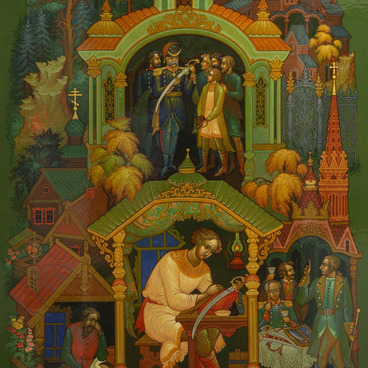The ink set from the collection of the Museum of Stone-Cutting and Jewelry Art History previously belonged to writer Alexander Tikhonov. It was donated to the museum by his relatives.
The set consists of two glass inkpots with bronze lids and a sculpture of an angel holding a tablet with the inscription in French: “Do not forget to write”. All objects are placed on a metal base with a stone insert in the center: it is lined with thin plates of malachite in the Russian mosaic technique. On the upper part of the insert is a small hollow, probably, for a fountain pen.
The author of this item is unknown. The ink set was probably made in the second half of the nineteenth century in Italy. However, the malachite for it came from the Urals, it can be determined by the pattern of the stone, reminiscent of crumpled velvet.
Soviet writer Alexander Tikhonov was born on November 1, 1880, in the village of Verkhneserginsky Zavod, Perm Governorate (presently — Verkhniye Sergi, Sverdlovsk Oblast). He studied at the Alekseyevsky Realschule in Yekaterinburg, and then entered the St. Petersburg Institute of Technology. However, in 1898 Tikhonov was expelled and sent to the Urals, because he participated in revolutionary student clubs.
In 1908, Alexander Tikhonov graduated from the St. Petersburg Mining Institute and worked for several years as a Geology engineer in the Urals and Siberia. Because of his profession, his pseudonym was Serebrov (from Russian “serebro” — silver). In 1912, the novice writer headed the department of fiction in the Bolshevik newspapers “Zvezda” and “Pravda”. Then, along with Maxim Gorky, he founded a similar department in the magazine “Prosveshchenie” (Enlightenment).
After the revolution, Tikhonov headed the publishing house “Vsemirnaya literatura” (World Literature), which printed the best works of the 18th and 20th centuries. According to Maxim Gorky, these books represent “a vast historical and literary chrestomathy, which will enable the reader to become acquainted in detail with the emergence, creation and decline of literary schools”. At the same time, Tikhonov worked for the magazines “Vostok” (East), “Russkiy Sovremennik” (Russian Contemporary) and “Sovremenniy Zapad” (Contemporary West), and edited books from the series “The Lives of Wonderful People”.
The set consists of two glass inkpots with bronze lids and a sculpture of an angel holding a tablet with the inscription in French: “Do not forget to write”. All objects are placed on a metal base with a stone insert in the center: it is lined with thin plates of malachite in the Russian mosaic technique. On the upper part of the insert is a small hollow, probably, for a fountain pen.
The author of this item is unknown. The ink set was probably made in the second half of the nineteenth century in Italy. However, the malachite for it came from the Urals, it can be determined by the pattern of the stone, reminiscent of crumpled velvet.
Soviet writer Alexander Tikhonov was born on November 1, 1880, in the village of Verkhneserginsky Zavod, Perm Governorate (presently — Verkhniye Sergi, Sverdlovsk Oblast). He studied at the Alekseyevsky Realschule in Yekaterinburg, and then entered the St. Petersburg Institute of Technology. However, in 1898 Tikhonov was expelled and sent to the Urals, because he participated in revolutionary student clubs.
In 1908, Alexander Tikhonov graduated from the St. Petersburg Mining Institute and worked for several years as a Geology engineer in the Urals and Siberia. Because of his profession, his pseudonym was Serebrov (from Russian “serebro” — silver). In 1912, the novice writer headed the department of fiction in the Bolshevik newspapers “Zvezda” and “Pravda”. Then, along with Maxim Gorky, he founded a similar department in the magazine “Prosveshchenie” (Enlightenment).
After the revolution, Tikhonov headed the publishing house “Vsemirnaya literatura” (World Literature), which printed the best works of the 18th and 20th centuries. According to Maxim Gorky, these books represent “a vast historical and literary chrestomathy, which will enable the reader to become acquainted in detail with the emergence, creation and decline of literary schools”. At the same time, Tikhonov worked for the magazines “Vostok” (East), “Russkiy Sovremennik” (Russian Contemporary) and “Sovremenniy Zapad” (Contemporary West), and edited books from the series “The Lives of Wonderful People”.



